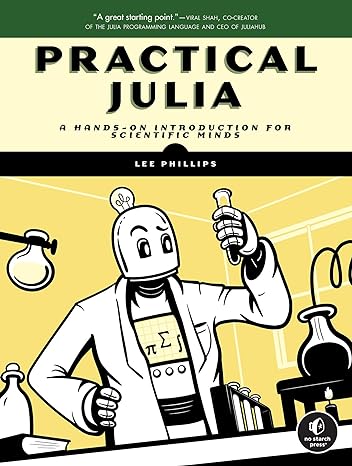
단행본2024년 BEST 302024년 9월 TOP 10
Practical Julia: A Hands-On Introduction for Scientific Minds
- 발행사항
- San Francisco : No Starch Press, 2023
- 형태사항
- xxvii, 499p. : illustrations ; 24cm
- 서지주기
- Includes index
소장정보
| 위치 | 등록번호 | 청구기호 / 출력 | 상태 | 반납예정일 |
|---|---|---|---|---|
지금 이용 불가 (1) | ||||
| 자료실 | E208336 | 대출중 | 2025.08.27 | |
지금 이용 불가 (1)
- 등록번호
- E208336
- 상태/반납예정일
- 대출중
- 2025.08.27
- 위치/청구기호(출력)
- 자료실
책 소개
The Julia programming language is acclaimed in scientific circles for its unparalleled ease, interactivity, and speed. Practical Julia is a comprehensive introduction to the language, making it accessible even if you’re new to programming.
Dive in with a thorough guide to Julia’s syntax, data types, and best practices, then transition to craft solutions for challenges in physics, statistics, biology, mathematics, scientific machine learning, and more. Whether you’re solving computational problems, visualizing data, writing simulations, developing specialized tools, Practical Julia will show you how.
As you work through the book, you’ll:
• Use comprehensions and generators, higher-level functions, array initialization and manipulation, and perform operations on Unicode text
• Create new syntax and generate code with metaprogramming and macros, and control the error system to manipulate program ution
• Visualize everything from mathematical constructs and experimental designs to algorithm flowcharts
• Elevate performance using Julia’s unique type system with multiple dispatch
• Delve into scientific packages tailored for diverse fields like fluid dynamics, agent-based modeling, and image processing
Whether your interest is in scientific research, statistics, mathematics, just the fun of programming with Julia, Practical Julia will have you writing high-performance code that can do real work in no time.
Online Resources: Ready-to-run code samples, illustrations, and supplemental animations available at https://julia.lee-phillips.org.
목차
Introduction
PART I: LEARNING JULIA
Chapter 1: Getting Started
Chapter 2: Language Basics
Chapter 3: Modules and Packages
Chapter 4: The Plotting System
Chapter 5: Collections
Chapter 6: Functions, Metaprogramming, and Errors
Chapter 7: Diagrams and Animations
Chapter 8: The Type System
PART II: APPLICATIONS
Chapter 9: Physics
Chapter 10: Statistics
Chapter 11: Biology
Chapter 12: Mathematics
Chapter 13: Scientific Machine Learning
Chapter 14: Signal and Image Processing
Chapter 15: Parallel Processing
Index
